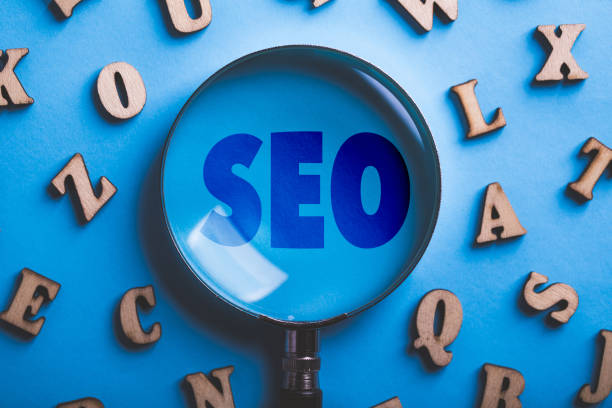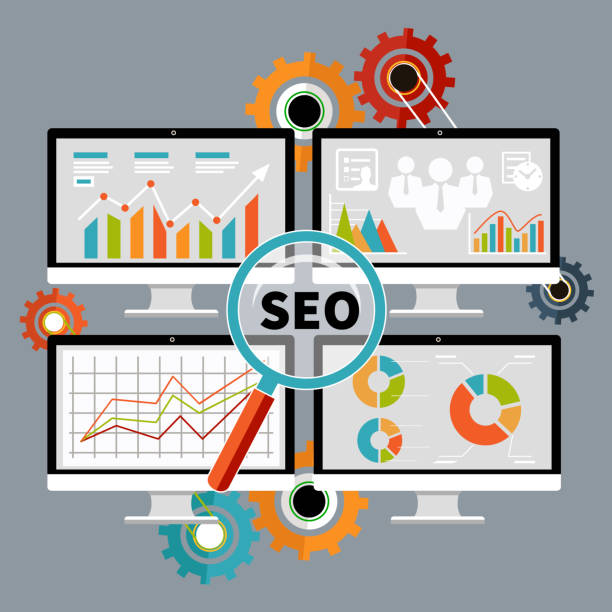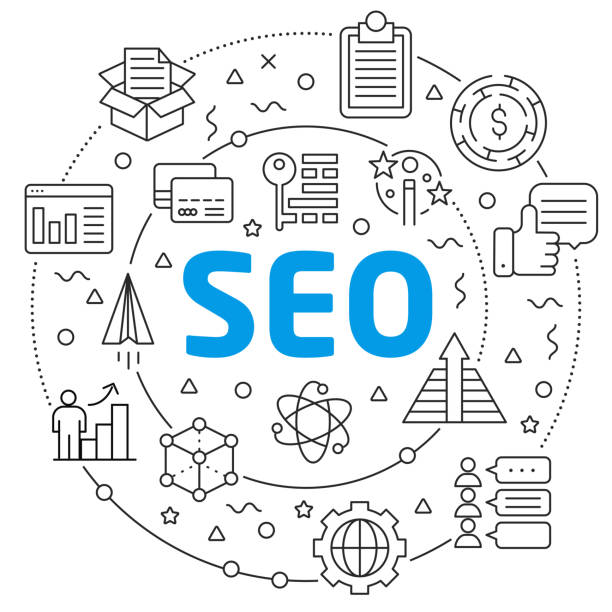Introduction to SEO and its Importance in the Digital World

In the current era, where the internet has become an inseparable part of daily life, having a website is merely the first step for an online presence.
To be seen among a plethora of information and tough competitors, Search Engine Optimization (SEO) is vital.
SEO is an explanatory and complex process aimed at improving a website’s ranking in organic search engine results like Google.
Without SEO, even the best content or most valuable products may never reach their target audience.
This educational and continuous process involves a series of on-page and off-page actions that help search engines better understand your content and deem it more relevant to user queries.
Through a strong SEO strategy, not only can you attract more traffic to your site, but this traffic is often of higher quality and more targeted, as it comes from users actively seeking services or information related to your field of activity.
The importance of SEO is not limited to increasing visits; it also directly impacts brand credibility, sales growth, and solidifying your market position.
In fact, SEO is a long-term investment that yields significant returns for online businesses.
Learning the principles of SEO is essential for anyone serious about having a strong online presence.
This article provides an explanatory and step-by-step examination of various aspects of SEO to help you achieve top rankings.
#SEO #Optimization #Search_Engines #Website_Traffic.
Are you bothered by losing customers who visited your site to make a purchase?
RasaWeb is your specialized solution for a successful online store.
✅ Significant increase in your online sales
✅ Building professional trust and branding with customers⚡ Get a free consultation from RasaWeb experts!
Types of SEO and Understanding Their Key Differences

SEO is a vast field that can be divided into various sections, each focusing on a specific aspect of optimization.
Understanding these classifications is crucial for developing a specialized and comprehensive SEO strategy.
The three main types of SEO include On-Page SEO, Off-Page SEO, and Technical SEO.
On-Page SEO refers to all actions performed within your website to improve its ranking.
These actions include content optimization, proper keyword usage, optimizing titles and meta descriptions, URL structure, image optimization, and improving user experience.
The primary goal of On-Page SEO is to send clear signals to search engines about the topic and quality of your content.
Off-Page SEO refers to activities performed outside your website, aiming to increase your domain’s authority and credibility.
The most important part of Off-Page SEO is Link Building, which involves acquiring links from other reputable websites.
Activities such as social media marketing, forum participation, and online advertising can also indirectly influence Off-Page SEO.
Finally, Technical SEO focuses on improving the technical aspects of a website to make it easier for search engines to crawl and index.
Site loading speed, mobile compatibility, code structure, Robots.txt file, Sitemap, and the use of HTTPS protocol are among the items examined in Technical SEO.
A clear and deep explanatory understanding of each of these sections will help you optimize your SEO strategy and utilize all available capacities to achieve high rankings.
Keywords: The Beating Heart of SEO Strategy

Keywords are the backbone of any successful SEO strategy, and understanding and optimizing them is a vital guide for any online business.
Without the right keywords, even the best content may never be discovered by the target audience.
The process of finding suitable keywords involves researching, analyzing, and selecting phrases that users type into search engines.
These keywords can range from short and general terms (like “SEO”) to longer and more specific phrases (like “comprehensive SEO guide for small businesses in Tehran”).
Keyword research tools like Google Keyword Planner, Ahrefs, and Semrush help you assess search volume, competition level, and keyword relevance.
The goal of keyword research is not just to find high-volume keywords, but to find keywords related to User Intent.
Is the user looking for information? A purchase? Or comparing products? Answering these questions helps you create content tailored to your audience’s actual needs.
Using keywords in the title, meta descriptions, content body, subheadings, and website URL is of particular importance.
However, remember that artificially stuffing content with keywords (Keyword Stuffing) is not only ineffective but can also harm your ranking.
The correct approach is to use keywords naturally and logically throughout the text.
This section is specialized and analytical, requiring continuous attention and review.
| Keyword Type | Description | Example |
|---|---|---|
| Short-Tail | General and broad, high search volume, high competition. | “shoes” |
| Mid-Tail | More specific, moderate search volume and competition. | “men’s athletic shoes” |
| Long-Tail | Very specific, lower search volume, higher conversion rate. | “best men’s athletic shoes for running in the rain” |
Optimizing Content for SEO and Users

Content is king in SEO, and this statement never loses its value.
However, simply producing content is not enough; your content must be optimized for both search engines and users.
A high-quality and engaging content is the foundation for attracting organic traffic and increasing conversion rates.
To produce optimized content, you must first address your audience’s needs and questions.
Thought-provoking content, which addresses users’ challenges and concerns, can lead to high engagement.
This type of content makes users think and interact with the topic.
Naturally use the keywords you identified in the previous step within the text.
Remember that keyword density should not be so high that the content loses its natural flow.
Content structure is also highly important; using subheadings (H1, H2, H3), short paragraphs, bulleted lists, and relevant images can significantly improve readability.
Your content should be comprehensive, accurate, and reliable.
Use credible sources for your information and link to them when necessary.
Content SEO also includes optimization for user experience (UX).
Page loading speed, responsive design, and easy navigation all affect how users interact with your content and, consequently, your SEO ranking.
Consistent content production and updating old content also send a positive signal to search engines, indicating your website’s activity and dynamism.
This section is a complete guide to producing effective content.
Do you have an online store, but your sales aren’t as expected? RasaWeb solves your problem forever by designing professional e-commerce websites!
✅ Significant increase in conversion rates and sales
✅ Unparalleled user experience for your customers
⚡ Click to get a free consultation with RasaWeb!
Link Building and Its Essential Role in Improving SEO Rank

Link Building is one of the most important and challenging aspects of external SEO.
Links are considered a “vote of confidence” from other websites to your site.
The more high-quality and relevant links pointing to your site, the more credible and trustworthy search engines deem your website, and consequently, they assign it a higher ranking.
However, not all links are created equal.
Link quality is more important than quantity.
A single link from a reputable and relevant website is far more valuable than dozens of links from spammy or irrelevant websites.
There are various link-building strategies, including: creating valuable content that naturally attracts links (link bait), guest posting on other websites, requesting links from partners or suppliers, and broken link building.
The key point in link building is for the process to be natural and gradual.
Search engines have complex algorithms to identify unnatural link-building patterns that can lead to your website being penalized.
In addition to inbound links (Backlinks), internal links also play an important role in SEO.
Internal links help search engines better understand your website’s structure and distribute page authority across the site.
Using relevant and natural anchor texts is also important in link building.
This field requires specialized knowledge and precise execution to achieve the best results in search engine optimization.
A clear and deep explanatory understanding of link-building strategies is one of the fundamental steps in achieving SEO success.
Technical SEO and Website Structure Optimization

Alongside content and links, the technical aspects of a website also play a crucial role in SEO success.
Technical SEO ensures that your website is easily accessible, crawlable, and indexable by search engine crawlers.
If search engines cannot properly access your site or understand its structure, it doesn’t matter how great your content is or how high-quality your links are, you won’t achieve a good ranking.
Site loading speed is one of the most important factors in technical SEO.
Both users and search engines prefer fast pages.
Tools like Google PageSpeed Insights can help you identify and fix speed issues.
Mobile compatibility is also highly important, as a large portion of searches are done via mobile devices, and Google uses a Mobile-First Indexing approach.
Optimized URL structure, using an XML Sitemap to guide search engines, and a Robots.txt file to control crawler access are all key components of technical SEO.
Implementing an SSL certificate and using the HTTPS protocol is not only essential for user security but is also recognized as a ranking factor.
Structured Markups (Schema Markup) also help search engines better understand your content and display it in a richer way in search results (like Rich Snippets).
This aspect of SEO is highly specialized and often requires knowledge of coding and web infrastructure.
Proper execution of these measures is a fundamental guide to ensuring your website’s technical health.
Data Analysis in SEO Using Tools

SEO is not a static process; rather, it requires continuous monitoring, data analysis, and ongoing optimizations.
Without the right tools and analytical capability, you cannot measure the performance of your SEO strategy and identify its strengths and weaknesses.
Google Analytics and Google Search Console are two essential and free tools that every SEO specialist should work with.
Google Analytics provides comprehensive information about user behavior on your website, including the number of visitors, time spent on the site, pages visited, and bounce rate.
This data helps you understand how users interact with your content and which aspects of the user experience need improvement.
Google Search Console focuses on the technical aspects and site performance in search results.
This tool shows you which keywords your site ranks for, which pages have crawl errors, and which links point to your site.
Additionally, paid tools like Ahrefs, Semrush, and Moz offer more advanced features for keyword research, competitor analysis, rank tracking, and backlink analysis.
Precise analysis of this data allows you to make data-driven decisions and improve your SEO strategy more effectively.
This stage is a vital guide for continuing the optimization journey, and without it, your optimization will be blind.
| Tool | Main Application | Type (Free/Paid) |
|---|---|---|
| Google Analytics | User behavior analysis, website traffic. | Free |
| Google Search Console | Search performance monitoring, crawl errors, ranked keywords. | Free |
| Ahrefs/Semrush/Moz | Advanced keyword research, competitor analysis, backlink review. | Paid |
Local SEO and Its Importance for Physical Businesses

While many aspects of SEO focus on attracting global or national audiences, Local SEO is of immense importance for businesses that serve customers in a specific geographical area.
Local SEO helps optimize your business’s online presence to appear in local search results when users are looking for products or services near their location.
For example, if someone searches for “Italian restaurant near me,” Local SEO will play a decisive role in displaying your business.
The most important tool for Local SEO is Google My Business (now Google Business Profile).
Creating and accurately optimizing your business profile in Google My Business, including entering precise contact information, operating hours, photos, services offered, and responding to customer reviews, is the first and vital step.
Gaining positive reviews from real customers also significantly impacts your local ranking.
Ensuring consistency of NAP (Name, Address, Phone) information across all online platforms, including local directories, is also important for strengthening local signals.
Explanatory content related to a specific geographical area can also help Local SEO.
For instance, writing articles about local events or news related to your area.
This section of SEO can also provide useful information to users in a news-like format and improve opportunities for guidance and connection with local customers.
Do you have an online store, but your sales aren’t as expected? RasaWeb solves your problem forever by designing professional e-commerce websites!
✅ Significant increase in conversion rates and sales
✅ Unparalleled user experience for your customers
⚡ Click to get a free consultation with RasaWeb!
New SEO Trends and the Future of Search Engine Optimization

The world of SEO never stands still and is constantly evolving.
Search engine algorithms are continuously updated, and new trends emerge that affect optimization success.
Awareness of these news-related trends and adapting to them is essential to maintain and improve your ranking.
Artificial Intelligence and Machine Learning (such as Google’s RankBrain algorithm) play an increasing role in how content is understood and ranked.
These algorithms are capable of better understanding user intent and the meaning behind words, even if keywords don’t precisely match.
Therefore, focusing on content quality, comprehensiveness, and semantic relevance has become even more important.
Voice search is also a growing trend.
With the increasing use of voice assistants like Siri, Alexa, and Google Assistant, the way users search has changed.
Voice searches are typically longer and more conversational.
Optimizing for voice search involves focusing on long-tail keywords, answering direct questions, and providing information in a Q&A (FAQ) format.
User Experience (UX) has also increasingly become a direct ranking factor.
Google’s Core Web Vitals (including Largest Contentful Paint, First Input Delay, Cumulative Layout Shift) are metrics that measure page experience quality and have a direct impact on SEO.
Video content and podcasts are also gaining increasing popularity, and optimizing them for search engines provides a new opportunity.
Finally, Personalization of search results has also created new challenges for SEOs.
Facing these trends can be entertaining and exciting and provide valuable guidance to online businesses in the long run.
Challenges and Advanced Tips in SEO and Their Solutions

The path of SEO is not always smooth, and there are challenges along the way.
From algorithmic penalties to fierce competition, facing these challenges requires deep knowledge and a continuous learning approach.
One of the main challenges is Google’s continuous algorithm updates.
These updates can suddenly change your website’s ranking.
To counter this, it’s important to always focus on SEO fundamentals: high-quality content, excellent user experience, and natural links.
In fact, a stable and resilient SEO strategy against changes is built on providing the best value to the user.
Another challenge is fierce competition in many industries.
To stand out, you need to identify your strengths and focus on less competitive but relevant keywords.
Entering Niche Markets can be an effective strategy.
Duplicate Content and slow site speed are also common problems that can harm your SEO ranking.
Using Canonical Tags for duplicate content and optimizing images and website code to increase loading speed are helpful guidance solutions.
For specialized SEOs, a deep understanding of Search Intent, optimizing for Featured Snippets, and using Structured Data (Schema Markup) can help them achieve higher rankings.
Furthermore, focusing on user satisfaction and providing real value will always be the best and most sustainable strategy against any SEO challenge.
These tips can serve as a guide for addressing advanced issues.
Frequently Asked Questions
| Question | Answer |
|---|---|
| What is SEO? | SEO, or Search Engine Optimization, is the process of increasing the quality and quantity of website traffic by improving the site’s ranking in organic search engine results like Google. |
| What are the main types of SEO? | SEO is divided into three main categories: On-Page SEO, Off-Page SEO, and Technical SEO. |
| What does On-Page SEO include? | On-Page SEO includes optimizing elements within the website, such as keywords, Title Tags, Meta Descriptions, content, URL structure, images, and internal links. |
| What is Off-Page SEO? | Off-Page SEO refers to activities outside the website that help improve its ranking, such as Backlink Building, social media marketing, and Brand Mentions. |
| What is Technical SEO? | Technical SEO focuses on optimizing the technical aspects of a website to help search engines crawl and index it better. This includes site speed, mobile-friendliness, site structure, Sitemaps, and the Robots.txt file. |
| What role do Keywords play in SEO? | Keywords are phrases that users enter into search engines. Proper and targeted use of relevant keywords in content and site elements helps search engines understand your page’s topic and display it for relevant searches. |
| What is a Backlink and why is it important? | A backlink, or inbound link, is a link from one website to another. Backlinks act as a “vote of confidence” from other sites to search engines and play an important role in the credibility and ranking improvement of a site, especially if they are from reputable sites. |
| What is the impact of quality content on SEO? | Quality, relevant, comprehensive, and unique content not only attracts and retains users but also shows search engines that your page is valuable. This helps improve ranking, reduce Bounce Rate, and increase user time on site. |
| Why is site loading speed important for SEO? | Site loading speed is an important ranking factor for Google. Faster sites provide a better user experience, have lower bounce rates, and are preferred by search engines. |
| Is SEO a one-time process? | No, SEO is a continuous and long-term process. Search engine algorithms are constantly changing, competition is increasing, and site content also needs updating. Therefore, SEO requires continuous monitoring, analysis, and optimization. |
And other services of RasaWeb Advertising Agency in the field of advertising
Smart Brand Identity: An innovative platform for improving website traffic with Google Ads management.
Smart Customer Journey Map: Designed for businesses looking to increase website traffic through user experience customization.
Smart Customer Journey Map: Revolutionize campaign management with intelligent data analysis.
Smart Custom Software: A blend of creativity and technology for analyzing customer behavior through key page optimization.
Smart Advertising Campaign: Professional optimization to attract customers using an SEO-driven content strategy.
And over hundreds of other services in the field of internet advertising, advertising consultation, and organizational solutions
Internet Advertising | Advertising Strategy | Advertorials
Resources
Comprehensive SEO Guide MihanWPComprehensive SEO Training SEOkarSEO Tips for Beginners IranHostWhat is SEO? Kalameh
? Are you ready to transform your business in the digital world? RasaWeb Afarin Digital Marketing Agency, with a specialized team and an innovative approach, offers comprehensive and effective solutions for your powerful online presence.
From website design with a modern user interface and professional SEO to smart social media management and targeted advertising campaigns, we provide everything you need for your online brilliance. Take a big step towards sustainable success with RasaWeb Afarin.
📍 Tehran, Mirdamad Street, next to Bank Markazi, Kazeroun Jonoubi Alley, Ramin Alley, No. 6




